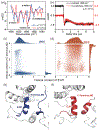Dynamical and allosteric regulation of photoprotection in light harvesting complex II
- PMID: 33163014
- PMCID: PMC7643867
- DOI: 10.1007/s11426-020-9771-2
Dynamical and allosteric regulation of photoprotection in light harvesting complex II
Abstract
Major light-harvesting complex of photosystem II (LHCII) plays a dual role in light-harvesting and excited energy dissipation to protect photodamage from excess energy. The regulatory switch is induced by increased acidity, temperature or both. However, the molecular origin of the protein dynamics at the atomic level is still unknown. We carried out temperature-jump time-resolved infrared spectroscopy and molecular dynamics simulations to determine the energy quenching dynamics and conformational changes of LHCII trimers. We found that the spontaneous formation of a pair of local α-helices from the 310-helix E/loop and the C-terminal coil of the neighboring monomer, in response to the increased environmental temperature and/or acidity, induces a scissoring motion of transmembrane helices A and B, shifting the conformational equilibrium to a more open state, with an increased angle between the associated carotenoids. The dynamical allosteric conformation change leads to close contacts between the first excited state of carotenoid lutein 1 and chlorophyll pigments, facilitating the fluorescence quenching. Based on these results, we suggest a unified mechanism by which the LHCII trimer controls the dissipation of excess excited energy in response to increased temperature and acidity, as an intrinsic result of intense sun light in plant photosynthesis.
Keywords: FTIR; LHCII photoprotection; T-jump; conformational dynamics and allostery; excited energy transfer; fluorescence quenching; protein switch.
Conflict of interest statement
Conflict of interest The authors declare no conflict of interest.
Figures







Similar articles
-
Cryo-EM structures of LHCII in photo-active and photo-protecting states reveal allosteric regulation of light harvesting and excess energy dissipation.Nat Plants. 2023 Sep;9(9):1547-1557. doi: 10.1038/s41477-023-01500-2. Epub 2023 Aug 31. Nat Plants. 2023. PMID: 37653340
-
Investigation of Transient Temperature Rising of Light-Harvesting Complex II by Nonradiative Heat Dissipation at the Protein Level.J Phys Chem Lett. 2025 Jan 9;16(1):308-316. doi: 10.1021/acs.jpclett.4c03056. Epub 2024 Dec 26. J Phys Chem Lett. 2025. PMID: 39723969
-
Unraveling the Excited-State Dynamics and Light-Harvesting Functions of Xanthophylls in Light-Harvesting Complex II Using Femtosecond Stimulated Raman Spectroscopy.J Am Chem Soc. 2020 Oct 14;142(41):17346-17355. doi: 10.1021/jacs.0c04619. Epub 2020 Sep 16. J Am Chem Soc. 2020. PMID: 32878439 Free PMC article.
-
Energy transfer reactions involving carotenoids: quenching of chlorophyll fluorescence.J Photochem Photobiol B. 1996 Oct;36(1):3-15. doi: 10.1016/S1011-1344(96)07397-6. J Photochem Photobiol B. 1996. PMID: 8988608 Review.
-
Interaction of pigment-protein complexes within aggregates stimulates dissipation of excess energy.Biochemistry (Mosc). 2004 Nov;69(11):1299-304. doi: 10.1007/s10541-005-0075-6. Biochemistry (Mosc). 2004. PMID: 15627383 Review.
Cited by
-
Ultrasound-controlled drug release and drug activation for cancer therapy.Exploration (Beijing). 2021 Dec 28;1(3):20210023. doi: 10.1002/EXP.20210023. eCollection 2021 Dec. Exploration (Beijing). 2021. PMID: 37323693 Free PMC article. Review.
-
Cold-induced calreticulin OsCRT3 conformational changes promote OsCIPK7 binding and temperature sensing in rice.EMBO J. 2023 Jan 4;42(1):e110518. doi: 10.15252/embj.2021110518. Epub 2022 Nov 7. EMBO J. 2023. PMID: 36341575 Free PMC article.
-
The mechanism for thermal-enhanced chaperone-like activity of α-crystallin against UV irradiation-induced aggregation of γD-crystallin.Biophys J. 2022 Jun 21;121(12):2233-2250. doi: 10.1016/j.bpj.2022.05.032. Epub 2022 May 26. Biophys J. 2022. PMID: 35619565 Free PMC article.
-
Cryo-EM structures of LHCII in photo-active and photo-protecting states reveal allosteric regulation of light harvesting and excess energy dissipation.Nat Plants. 2023 Sep;9(9):1547-1557. doi: 10.1038/s41477-023-01500-2. Epub 2023 Aug 31. Nat Plants. 2023. PMID: 37653340
-
Large-scale integration of meta-QTL and genome-wide association study identifies genomic regions and candidate genes for photosynthetic efficiency traits in bread wheat.BMC Genomics. 2025 Mar 22;26(1):284. doi: 10.1186/s12864-025-11472-6. BMC Genomics. 2025. PMID: 40121401 Free PMC article.
References
-
- Demmig-Adams B, Garab G, Adams W III, Govindjee. Non-photochemical quenching and energy dissipation in plants, algae and cyanobacteria. In: Govindjee, Sharkey TD, Eds. Advances in Photosynthesis and Respiration Including Bioenergy and Related Processes. Vol 40 The Netherlands: Springer Science & Business Media, 2014
-
- Rochaix JD. Annu Rev Plant Biol, 2014, 65: 287–309 - PubMed
-
- Ruban AV. FEBS Lett, 2018, 592: 3030–3039 - PubMed
Grants and funding
LinkOut - more resources
Full Text Sources
